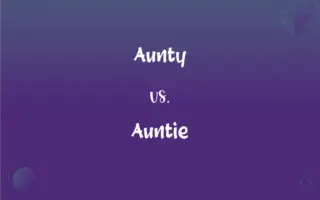Language Acquisition vs. Language Learning: What's the Difference?
Edited by Aimie Carlson || By Janet White || Published on January 25, 2024
Language acquisition is the subconscious absorption of language, typically in childhood, while language learning involves conscious teaching and study.

Key Differences
Language acquisition typically refers to the natural process of gaining language ability, often observed in children as they absorb and understand their native language without formal instruction. Language learning, in contrast, is a more structured process where individuals consciously study a language's grammar, vocabulary, and usage, often in a classroom setting. While acquisition is a natural, intuitive process, learning is systematic and often requires deliberate effort and practice.
In language acquisition, children pick up nuances like pronunciation, syntax, and cultural idioms effortlessly, often without realizing they are learning. Language learning, however, usually involves adults or older children who use textbooks, exercises, and other educational tools to grasp a new language. This learning is more focused on rules and often lacks the natural fluency that comes with acquisition.
The theories behind language acquisition suggest it is linked to cognitive development and occurs during a critical period in early life. Language learning, on the other hand, does not rely on a critical period and can be undertaken at any age, although it may be more challenging as one gets older. Acquisition is tied to developmental stages, whereas learning is more about personal or academic goals.
Language acquisition often leads to native-like fluency and understanding, as it is intertwined with a person’s social and cultural environment. Language learning can achieve fluency, but it often requires more effort, and learners may retain an accent or have less intuitive grasp of idiomatic expressions. Acquisition is a more organic process, while learning is a more formalized journey.
In acquisition, errors are corrected naturally through interaction, without explicit grammar instruction. In language learning, errors are often addressed through formal correction and explanation, highlighting the difference in approach. Acquisition builds language skills seamlessly into daily life, whereas learning often separates language study from other daily activities.
ADVERTISEMENT
Comparison Chart
Method
Subconscious, natural absorption
Structured, conscious study
Typical Age
Childhood, during cognitive development
Any age, often older children and adults
Approach
Intuitive and implicit
Systematic and explicit
Outcome
Native-like fluency and intuition
Fluency with potential limitations (e.g., accent)
Error Correction
Natural, through interaction
Formal, through instruction and correction
ADVERTISEMENT
Language Acquisition and Language Learning Definitions
Language Acquisition
This process is subconscious and closely tied to cognitive development.
His rapid language acquisition showcases remarkable cognitive growth.
Language Learning
It involves conscious understanding and application of grammar rules and vocabulary.
Her language learning focused on mastering French grammar.
Language Acquisition
Language acquisition involves picking up grammar, vocabulary, and pronunciation organically.
Children's language acquisition is so efficient, they rarely need grammar lessons.
Language Learning
Language learning is the process of studying a language through formal education.
He improved his Spanish through dedicated language learning at school.
Language Acquisition
Language acquisition is most effective during a child's early years.
Early childhood is the optimal time for language acquisition.
Language Learning
Language learning often occurs in a classroom or through self-study.
They engaged in language learning via online courses.
Language Acquisition
It often occurs in children as they intuitively grasp language from their environment.
Her language acquisition was evident as she started forming sentences at two years old.
Language Learning
This process is systematic and can be undertaken at any age.
Starting language learning as an adult can be challenging but rewarding.
Language Acquisition
Language acquisition is the natural process of absorbing a language without formal instruction.
Through language acquisition, toddlers quickly learn to speak their native language.
Language Learning
Language learning may not always lead to native-like fluency.
Despite years of language learning, he still speaks with a noticeable accent.
FAQs
What is language acquisition?
It's the natural process of absorbing a language, typically observed in children.
What is language learning?
It's the structured study of a language, involving conscious learning of grammar and vocabulary.
Is language acquisition faster than language learning?
Yes, acquisition is typically faster and more intuitive, especially in children.
Can language learning be successful in a classroom?
Yes, many people successfully learn languages in a classroom setting.
Can adults experience language acquisition?
Adults primarily engage in language learning; natural acquisition is less common.
What role does environment play in language acquisition?
A rich linguistic environment is crucial for effective language acquisition.
At what age does language acquisition occur?
Language acquisition usually occurs in early childhood, up to about age 7.
Do language learners achieve native-like proficiency?
It's possible, but achieving native-like proficiency through learning alone can be challenging.
Are teaching materials necessary for language acquisition?
No, language acquisition occurs naturally without formal teaching materials.
How long does language learning typically take?
It varies, but language learning can take months to years, depending on effort and frequency of practice.
What's the best age for language learning?
While there's no 'best' age, younger learners often find it easier to mimic sounds and patterns.
Is grammar more important in language learning or acquisition?
Grammar is explicitly taught in language learning, whereas in acquisition, it's absorbed naturally.
What methods are used in language learning?
Methods include classroom instruction, textbooks, online courses, and language apps.
Can language acquisition and learning occur simultaneously?
Yes, especially in children who are formally learning one language while naturally acquiring another.
Is accent reduction part of language learning?
Yes, accent reduction can be a focus in language learning, especially for advanced learners.
How do children acquire language?
Children acquire language by interacting with and listening to those around them.
Is a teacher necessary for language acquisition?
A teacher isn't necessary; acquisition happens through natural exposure and interaction.
Can language acquisition lead to bilingualism?
Yes, when children acquire two languages simultaneously, they can become bilingual.
How important is practice in language learning?
Practice is crucial in language learning to reinforce knowledge and improve proficiency.
Does language acquisition require effort?
It's an effortless process for children, happening subconsciously.
About Author
Written by
Janet WhiteJanet White has been an esteemed writer and blogger for Difference Wiki. Holding a Master's degree in Science and Medical Journalism from the prestigious Boston University, she has consistently demonstrated her expertise and passion for her field. When she's not immersed in her work, Janet relishes her time exercising, delving into a good book, and cherishing moments with friends and family.
Edited by
Aimie CarlsonAimie Carlson, holding a master's degree in English literature, is a fervent English language enthusiast. She lends her writing talents to Difference Wiki, a prominent website that specializes in comparisons, offering readers insightful analyses that both captivate and inform.






































































